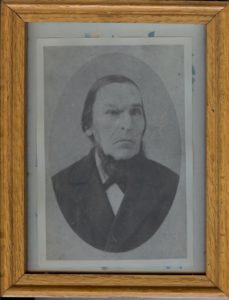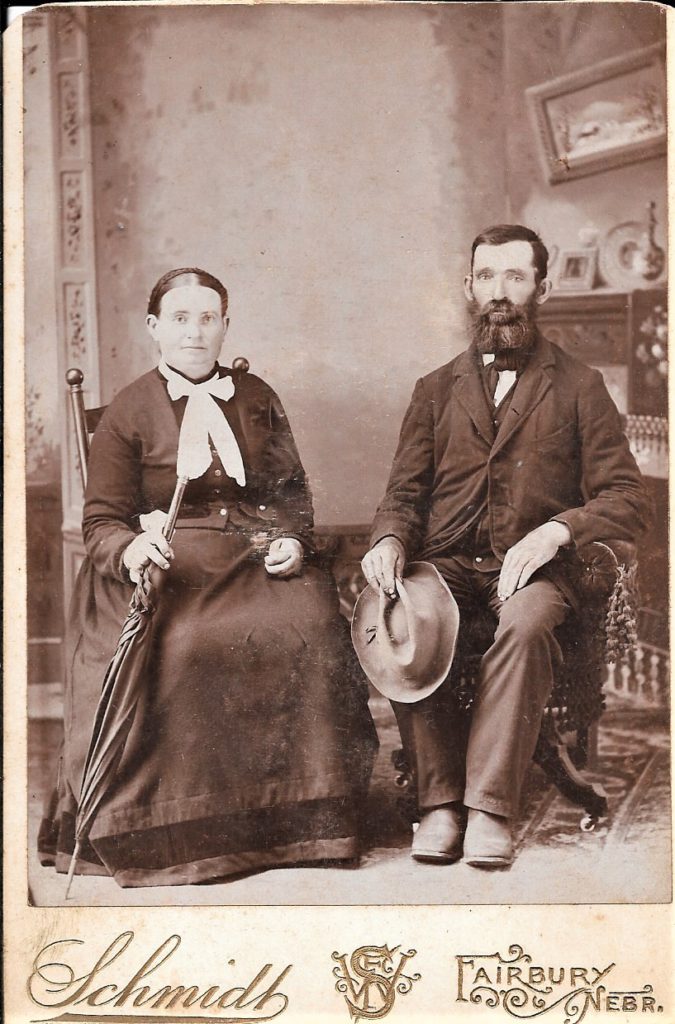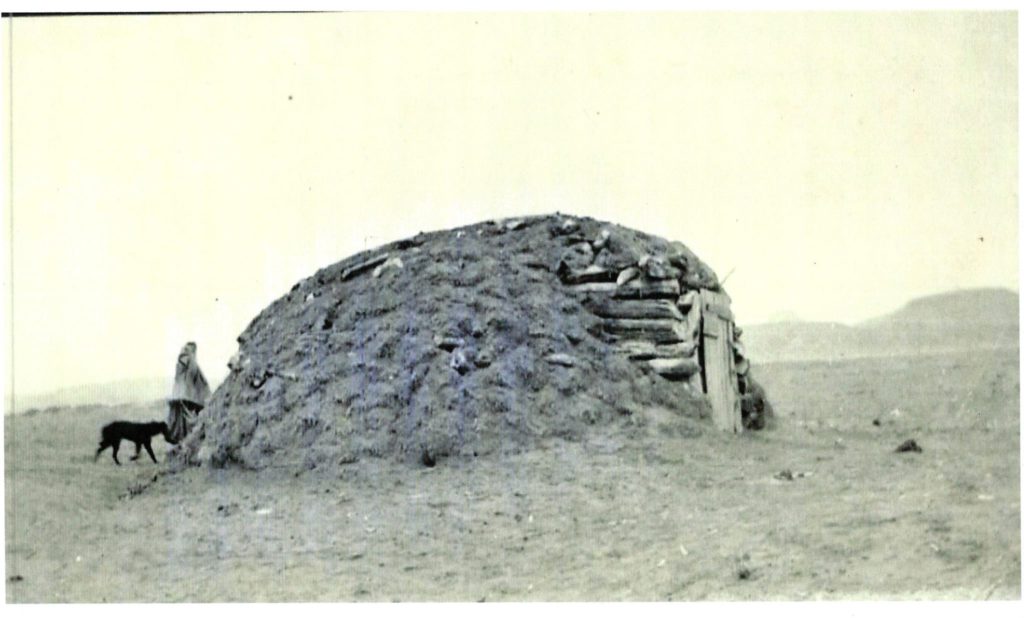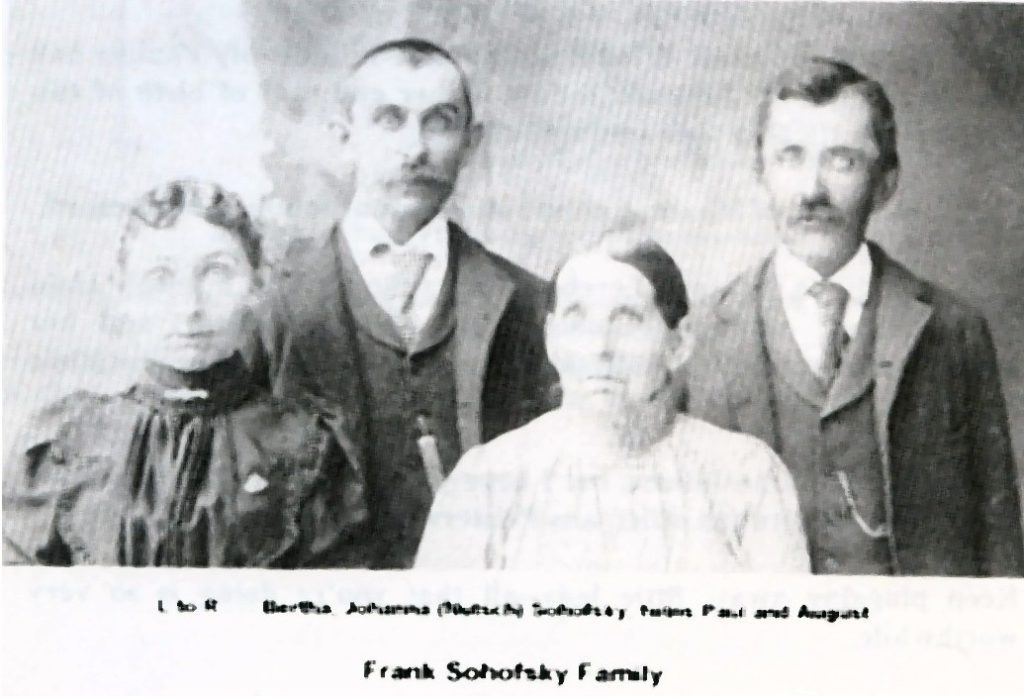
Johanna and Frank Sohofsky
Once Gottfried Nutsch made his way to Washington county and got settled nicely his family begin to follow him over. The next Nutsch sibling to come to Kansas was his sister Johanna and her husband Frank Sohofsky. Johanna’s family must have kept to themselves a bit more than the others and I have had to do quite a bit of searching in order to find the little information that I have found on her, but none the less…this is a link to our tree. Johanna and Frank Sohofsky make their way from Prussia to Kansas, and reunited with her brother Gottfried June 1884 .
Prussia History Lesson
To properly direct any genealogical information, you must know more about the country and specific location your ancestors came from. Prussia includes much of a large mass of the territory on the southeast coast of the Baltic Sea. Between 1668 and 1817 the country that is now called Germany was more than 300 independent states, city states, bishoprics, duchies, and more, some are very small regions with the exceptions in size, places like Bavaria.
There was no central government. Residents “belonged” to their little countries, which in some cases had two or more areas separated by other “countries”. They received orders to populate an area and were sent to start new towns, usually along a border, to ward off invasions. Much like the colonies when they were first started here in the United States.
To support the governments of such small properties, the merchants had to pay taxes in every little independent country they went through, whether by land or river, while traveling across the land to deliver goods, making goods almost impossible to afford.
Religion of an area was often designated by the royal leader of the time, and changed as leaders did. Churches were the primary keepers of family and individual information starting in the 1500’s. Most people worked in agriculture, for larger land owners as tenants. The lucky ones had small private farms that would barely sustain a family , and at the age of 10 years, children began to work alongside their parents to supplement family income.
Napoleon’s invasion ca. 1805 resulted in a reduction of the number of independent Germanic “nations” to 36. This remained the status until Prussia “united” those states and today’s Germany was formed in 1871.
Prussia, also “Preussen” and “Borussia” in old records, also claimed parts of Poland, Romania, Ruthvenia, and other formerly independent countries. Today, there is no Prussia on maps. Prussia is a name that has been applied to almost 60% of the German Empire at one time or another. Prussia includes much of a large mass of the territory on the southeast coast of the Baltic Sea from approximately 1850 to World War I.
From 1701, the Kingdom was ruled by the Hohenzollerns and Berlin was the capitol. There were more than three dozen duchy’s under Germanic control, including the following: Brandenburg Electoral Hesse Hesse-Nassau Mecklenburg Poland–portions of Pomerania Posen Rhineland–portions of Saxony Schleswig-Holstein Silesia Thuringia Westphalia and the Duchies of Burg, Cleve, Crossen, Engern, Geldern, Juelich, Magdeburg, Stettin and Wenden and Cassubia and others that were smaller in size.
Smaller than a Duchy are the church district, which often encompassed several villages. It is helpful to become familiar with German terms like state church, serf and elector, perhaps more. A German dictionary and/or the German language list in the LDS Guide to German Research are important tools. Church district is Kirchenkreis. Stadt, means town, as in BrombergStadt, the city, in the County of Bromberg and the administrative district of Bromberg, similar to the Posen, Posen, Posen. The kirchenkreis (commonly mis-named “Kreis-Stadt”) was the most important because that is how records were kept in the early 1800s. 1817 was the year that Friedrich Wilhelm III combined the Lutheran and Reformed denominations into Evangelisch.
It helps when doing German research to have an understanding of Prussian history, and what was happening during the critical emigration years of 1850-75, and that Prussia only officially controlled western Germany after 1871 as the First Reich. Those emigrating before 1850 had mostly two motivations: economic disaster as the Irish Potato famine spread, and religious freedom issues, the Prussian Union church vs the several centuries-old state supported “Old Lutherans” (Evangelische), and the conservative factions squeezed by the mandated mergers of the current kaiser.
Brandenburg was ruled by the Hohenzollern family in the Teutonic knights since after the crusades, although they also held smaller ancestral territories in West Germany. At the invitation of Polish knights they helped to subdue “native peoples” of Latvian type called Prussi, and were given control over that land. They built castles and colonized the land. Unrest led to expulsion of the Teutons, but a treaty in 1460 left them with what is called East Prussia, thus Brandenburg-Prussia was born. It evolved into a Duchy under Albert of Hohenzollern who also disbanded the knights who became the land holders in both areas.
Albert of Hohenzollern also declared Brandenburg-Prussia to be Lutheran, since the head of state designated a state church. That didn’t please the Catholics. John Sigismund, a Hohenzollern and good administrator came to power in 1618, and his grandson Frederick William, elector of Brandenburg, secured ducal Prussia’s independence of Poland in 1660. By this time there was a system of seven “electors”, a higher title than duke but short of “king” who were responsible for naming the “Holy Roman Emperor” to whom all were to be militarily supportive. Frederick-I enticed the Pope to agree to his being called King in Prussia in 1701, and he shortly changed that to King “of” Prussia. That was another “milestone” of the rise of Prussia as a military power. Creation of the Prussian Union church from the previous Reformed (which the kaiser was) and the “Old Lutherans” (which his wife was) became a religious freedom and doctrinal issue that resulted in emigration of many “Old Lutherans” in the 1830-40s. Prussia’s state church had been “Old Lutheran” since the reformation, but the heads of state had turned Reformed. This mandated consolidation into the Prussian Union that forced emigration was a major factor in creation of the two most conservative Lutheran groups in America, the Missouri synod and Wisconsin synods. All because he wanted to go to communion with his “Old Lutheran” wife in her church and the “Old Lutherans” refused it.
They didn’t practice altar and pulpit fellowship with the Reformed or anyone else, including the kaiser if he didn’t qualify. It didn’t help that the Kaiser enforced the merger by force of police, something his successor backed away from, but it was too late then. The timing coincided with the opening of America where the kaiser didn’t tell you how to worship and you could buy as much land as you could afford, a huge step forward from being able to even buy a little land at all. So the “Old Lutherans” gave him a salute and many left.
Wisconsin immigrants prior to 1860 numbered many “Old Lutherans” among them, and they were responsible for organizing the eastern Marquette County axis of Lutheran churches besides filling in from Milwaukee northward. Prussia was also exceedingly militaristic, from their Crusader roots, from about 1250 AD onward.
It took about 600 years to achieve control of the German states–Denmark in 1864 to secure two NW provinces, Austria in 1866, France in 1870, all of those to demonstrate to the other states that Prussia was ‘the best leader’. The frequent wars that were part of Prussia’s rise to prominence over the previous 200 years, andthe taxes that were enforced, were another major cause of emigration. Germans had formerly sought “Lebensraum” (living space) by Germans moving into Poland and Russia for more room, but the system of war and taxes to pay for the military unceasing and ever increasing. By 1850 emigration was beginning to replace the colonization of the former years.
Our ancestors chose to leave everything familiar and to come to America for a variety of reasons, the most common being a combination of over-crowding, high taxes, nearly continual war, some crop failures and the potato famine spreading through Europe, religious matters, and to allow their children to avoid the new compulsory military service. We are told that the most compelling reason for our Nutsch family to leave was to get away from the military and to find a more stable way of life.
Johanna the oldest child of Johann Nutsch
Some of the information provided here comes from the book “Reedy, Schuessler, Nutsch, and Koch of Washington, Kansas” by Phyllis Reedy James 1993 and I have added what I have found along the way.
Johanna Nutsch, oldest child of Johann I and Marie (Mueller) Nutsch, was born 1840 in Ohlau, Schlesien, Prussia and married in Prussia, to Frank Sohofsky who was born 7 Oct 1833 in Prussia. Johanna died 1920 in KS and was buried in St. Peter and Paul Cemetery, Washington Co., Ks. Frank died 27 Oct 1893 just south of the Nebraska line in Ks and was buried in St. Peter and Paul Cemetery, Washington Co., Kansas.
Johanna and Frank spent the first years of their married life in Germany and all their children were born there. The family, Johanna, Frank, August, Paul and Bertha, came to America on the ship Lessing sailed by Captian Voss. They departed Hamburg, Germany 22 June 1884 and arrived in New York, 7 July 1884. Their twin boys were 19 and their daughter Bertha was 16. After their arrival in New York they ventured on to Washington Co., Kansas probably by train. It is believed they lived with Johann’as brother Gottfried, until they could find a place of their own.
The farm where Johanna and Frank made their home was in Lowe Township, Washington Co., Kansas which was then located on what is now HWY 15 just south of Fairbury, Nebraska. Their house was constructed of limestone, which was a major construction material for most of the settlers and quarried locally. Frank died a shortly after arriving in America. Johanna and her two sons were left to continue farming their homestead . . Some records show Frank died 27 Oct 1883. St. Peter and Paul Cemetery records show his death as 2 Oct 1898.
Life was not easy for Johanna she struggled the many hardships of the time. She farmed the next few years with a team of oxen with the help of her two sons and daughter. She had no automobile, as some families did, and she would haul all her supplies by wagon, however this was the norm at that time so my guess is she barely thought much about it. It was no simple chore since the family lived several miles from the nearest town. Some relatives remember the family raising 800 lb. hogs. I don’t recall Grandpa speaking much of Johanna so it could be that they did not spend as much time with the family as the others but we do know that she was a member of the St. Peter and Paul church as were all the other Nutsches so they probably gathered there to socialize. Realizing that her husband died shortly after arriving in America, you know that life had to be extremely hard for her and I’m sure there were times that she felt overwhelmed. However, her children were adults so she very possibly had their help to keep things going on the farm.
Paul and August Sohofsky
Fourteen years after Frank died, a tragedy struck when Johanna’s son, August, was mowing, and his horses became frightened. During the runaway, August was thrown into the mower and both legs were severely damaged. Though the doctors did everything that was possible at the time, his one leg had to be amputated and August died a short time later, July 20, 1907.

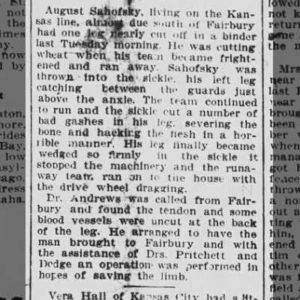
Paul and August twins born 1 Sep. 1864 in Germany never married. I found census records that states that Paul was living with his sister Bertha in Lincoln County at the time of his death August 4, 1941.
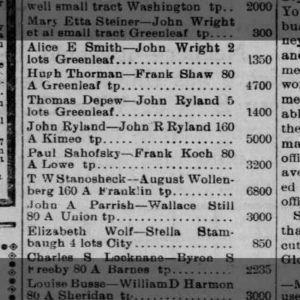 In 1908 he transferred land to Frank Koch (a brother to our great grandmother Creszencia and our great uncle.)
In 1908 he transferred land to Frank Koch (a brother to our great grandmother Creszencia and our great uncle.)
Bertha “Beillia” Sahofsky
Bertha was born in Prussia 19 August 1876 and came to America with her parents. The 1910 census shows her as widowed and living with her brother in law and his family, August May, and the occupation listed is “servant”. She secondly married Andrew J Hahn and they had one daughter, Anastasia (Anna) Hahn. The 1930 census shows her living Nowell, Lincoln, Nebraska, with Anna and is widowed and occupation listed as “farmerette” . The 1940 Census also shows her as widowed and living with Anna Hahn , and Sahofsky Hahn. Sahofsky is listed as her brother. This could possibly be Paul. To this point I have been unable to find any other information on her. She is listed on Find a grave as having died 25 December 1959 and is buried in North Platte, Lincoln County, Nebraska.
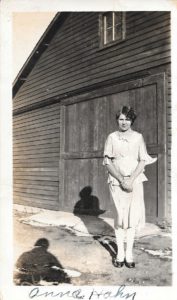
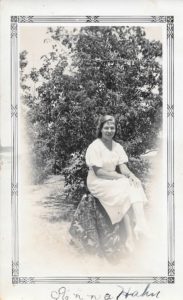
Anastasia Anna Hahn
Anastasia the only daughter of Andrew and Bertha Hahn was born 9 Oct 1915 in Hershey, Lincoln, Nebraska and died 30 June 1990, North Platte, Lincoln,Nebraska.
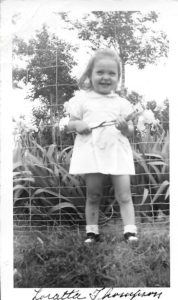


 Gottfried’s first homestead was 150 acres in Republic Co., Kansas near Cuba. He had a neighbor close by on another 160 acre homestead, Louis Stulle, who had married Barbara Rychtarik on April 11, 1873 in Republic Co., Kansas. According to their marriage license, Louis was age 29 and Barbara was 17. This marriage was short lived as soon after their marriage there was a prairie fire and Louis died as a result of fighting that fire. Barbara stayed on their 160 acre homestead and on November 30, 1873, Barbara and Gottfried were married. Their marriage license reads: GH Nutsch, of Republic Co., age 26 years, and Barbara Stulle of Republic Co., age 18, were married November 30, 1873. There is conflicting information regarding Barbara’s date of birth. Inscribed on Barbara and Gottfried’s tombstone is Gottfried H Nutsch Sept. 5 1844 – January 14,1928. And Barbara Rychtarik January 1 1847 – August 20, 1944.
Gottfried’s first homestead was 150 acres in Republic Co., Kansas near Cuba. He had a neighbor close by on another 160 acre homestead, Louis Stulle, who had married Barbara Rychtarik on April 11, 1873 in Republic Co., Kansas. According to their marriage license, Louis was age 29 and Barbara was 17. This marriage was short lived as soon after their marriage there was a prairie fire and Louis died as a result of fighting that fire. Barbara stayed on their 160 acre homestead and on November 30, 1873, Barbara and Gottfried were married. Their marriage license reads: GH Nutsch, of Republic Co., age 26 years, and Barbara Stulle of Republic Co., age 18, were married November 30, 1873. There is conflicting information regarding Barbara’s date of birth. Inscribed on Barbara and Gottfried’s tombstone is Gottfried H Nutsch Sept. 5 1844 – January 14,1928. And Barbara Rychtarik January 1 1847 – August 20, 1944.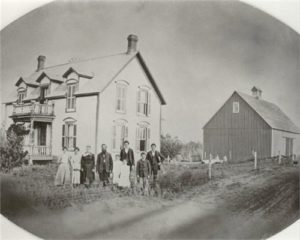 Gottfried and Barbara became large land owners in Kansas. It has been said they owned over 4,000 acres. This also included the land in Rooks Co., Kansas, however that is oral history. The records show Barbara’s name on most of the land in Washington Co.,
Gottfried and Barbara became large land owners in Kansas. It has been said they owned over 4,000 acres. This also included the land in Rooks Co., Kansas, however that is oral history. The records show Barbara’s name on most of the land in Washington Co.,